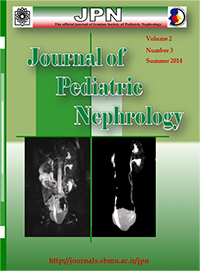Comparison of Two Intravenous Fluid Maintenance Therapy with Different Sodium Concentrations in Hospitalized Children: A Randomized Trial Study
Journal of Pediatric Nephrology,
Vol. 2 No. 3 (2014),
19 Mordad 2014
,
Page 110-115
https://doi.org/10.22037/jpn.v2i3.6358
Abstract
Introduction: Hyponatremia refers to the serum sodium levels less than 135 mEq/L, which can even lead to death. Accordingly, the present study compared the effects of intravenous fluid maintenance treatment with different concentration levels of sodium.
Materials and Methods: In an investigative study to evaluate children admitted to the Pediatric Intensive Care Unit (PICU) of Bahrami Children's Hospital (2012-2013) which required intravenous fluid therapy and aged one to 14 years were evaluated. They were randomly divided into two groups: fluid treatment with 50 mEq/L (group I) and 100 mEq/L (group II) sodium concentrations. The fluids were calculated according to Holliday-Segar formula. Sodium of plasma [P (Na)] and Urine specific gravity (USG) were measured at the time of admittance (first P (Na) and USG) and 24 hrs after treatment (second P (Na) and USG).
Results: 108 children were admitted into the study. Significant differences were noted in the second P (Na) levels and differing of first and second P (Na) (P<0.008 and P<0.011). In the first group, 14 cases and in second three cases were hyponatremia (P (Na) < 135 mmol/L), but they weren’t symptomatic during the study. The difference between first and second USG was greater in group I (P <0.023).
Conclusions: There was relation between the sodium of the IV fluid and decreased P (Na) concentration in the children who were undergoing intravenous (IV) fluid therapy. There were no Symptomatic hyponatremia cases reported, due to the decrease of P (Na), nor in the 24 hours following the IV therapy treatment.
Keywords: Fluid Therapy; Specific Gravity; Sodium; Hyponatremia
How to Cite
References
1. Barón FAJ, Meregalli CN. Hypotonic versus isotonic intravenous maintenance fluids in critically ill pediatric. Arch Argent Pediatr 2013;111(4):281-287.
Holliday MA, Segar WE. The maintenance need for water in parenteral fluid therapy. Pediatrics. 1957;19(5):823-32.
Moritz ML, Ayus JC. Hospital-acquired hyponatremia: why are there still deaths? Pediatrics. 2004;113(5):1395-6.
Duke T, Molyneux EM. Intravenous fluids for seriously ill children: time to reconsider. The Lancet. 2003;362(9392):1320-3.
Holliday MA, Ray PE, Friedman AL. Fluid therapy for children: facts, fashions and questions. Archives of disease in childhood. 2007;92(6):546-50.
Moritz ML, Ayus JC. Prevention of hospital-acquired hyponatremia: a case for using isotonic saline. Pediatrics. 2003;111(2):227-30.
Adrogué HJ, Madias NE. Hyponatremia. New England Journal of Medicine. 2000;342(21):1581-9.
Halberthal M, Halperin ML, Bohn D. Lesson of the week: Acute hyponatraemia in children admitted to hospital: retrospective analysis of factors contributing to its development and resolution. BMJ: British Medical Journal. 2001;322(7289):780.
Arieff AI, Ayus JC, Fraser CL. Hyponatraemia and death or permanent brain damage in healthy children. BMJ: British Medical Journal. 1992;304:1218-22.
Moritz ML, Ayus JC. Hospital-acquired hyponatremia—why are hypotonic parenteral fluids still being used? Nature Clinical Practice Nephrology 2007;3(7):374-82.
Hoorn EJ, Geary D, Robb M, Halperin ML, Bohn D. Acute hyponatremia related to intravenous fluid administration in hospitalized children: an observational study. Pediatrics 2004;113(5):1279-84.
Schrier RW, Bansal S. Diagnosis and management of hyponatremia in acute illness. Current opinion in critical care 2008;14(6):627.
Singhi S. Hyponatremia in hospitalized critically ill children: current concepts. The Indian Journal of Pediatrics 2004;71(9):803-7.
Rose BD. New approach to disturbances in the plasma sodium concentration. The American journal of medicine. 1986;81(6):1033-40.
Adrogué HJ, Madias NE. Hyponatremia. New England Journal of Medicine 2000;342(21):1581-9.
Rose B, Post T. Hypoosmolal states-hyponatremia. Clinical Physiology of Acid-Base and Electrolyte Disorders (4th ed), edited by Rose BD New York: McGraw-Hill. 2001:696-745.
DeVita M, Gardenswartz M, Konecky A, Zabetakis P. Incidence and etiology of hyponatremia in an intensive care unit. Clinical nephrology 1990;34(4):163-6.
Neville KA, Sandeman DJ, Rubinstein A, Henry GM, McGlynn M, Walker JL. Prevention of hyponatremia during maintenance intravenous fluid administration: a prospective randomized study of fluid type versus fluid rate. The Journal of pediatrics 2010;156(2):313-9.
Choong K, Arora S, Cheng J, Farrokhyar F, Reddy D, Thabane L, et al. Hypotonic versus isotonic maintenance fluids after surgery for children: a randomized controlled trial. Pediatrics 2011;128(5):857-66.
Wang J, Xu E, Xiao Y. Isotonic Versus Hypotonic Maintenance IV Fluids in Hospitalized Children: A Meta-Analysis. Pediatrics 2014;133(1):105-13.
Asadollahi K, Beeching N, Gill G. Hyponatraemia as a risk factor for hospital mortality. QJM 2006;99(12):877-80.
Yung M, Keeley S. Randomised controlled trial of intravenous maintenance fluids. Journal of paediatrics and child health 2009;45(1‐2):9-14.
Mathur A, Duke T, Kukuruzovic R, South M. Soluciones salinas hipotónicas versus isotónicas para los líquidos intravenosos en el tratamiento de las infecciones agudas. Resúmenes Cochrane 2009; 21 enero.
Montanana PA, i Alapont VM, Ocon AP, Lopez PO, Prats JLL, Parreño JDT. The use of isotonic fluid as maintenance therapy prevents iatrogenic hyponatremia in pediatrics: A randomized, controlled open study. Pediatr Crit Care Med 2008; 9(6):589-597.
Kannan L, Lodha R, Vivekanandhan S, Bagga A, Kabra SK, Kabra M. Intravenous fluid regimen and hyponatraemia among children: a randomized controlled trial. Pediatric nephrology. 2010;25(11):2303-9.
Wilkinson E, Rieff J, Rekate H, Beals S. Fluid, blood, and blood product management in the craniofacial patient. Pediatric neurosurgery. 1992;18(1):48-52.
- Abstract Viewed: 319 times
- PDF Downloaded: 4825 times

